
|
Warning!
At least some content in this article is derived from information featured in: Harry Potter: Wizards Unite & Harry Potter: Hogwarts Mystery. |

|
"Well, I think we should put it back in order for them, don't you?"
This entry needs to be cleaned up to conform to a higher standard of quality.
|
- "I can make things move without touching them. I can make animals do what I want without training them. I can make bad things happen to people who are mean to me. I can make them hurt if I want to..."
- — Young Tom Riddle describes his magical skills[src]
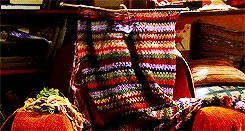
Knitting needles creating a scarf with the use of a Knitting Charm
Magic is a supernatural force that changes aspects of the world at fundamental levels. While magic is able to defy the known laws of science, it does follow its own set of rules. For example, Vanishment doesn't make objects cease to exist, but rather, according to Professor McGonagall, go "into non-being, which is to say, everything." Conjured objects can only exist for a temporary period of time, and objects cannot be enlarged beyond a certain point without becoming unstable and/or exploding. The ability for humans to use magic is a hereditary trait passed down from a person's ancestors, which allows witches and wizards to practise witchcraft and wizardry.
The basic concepts of magic are fairly simple — even a two-year-old wizard can do some form of magic — but the inherent power and potential for misuse are great indeed. It is for this reason that promising young witches and wizards are sent to schools of magic, such as Hogwarts School of Witchcraft and Wizardry to refine their craft and learn the art and responsibility of their power. There, they learn a variety of magical specialities, general theory and the history of magic in their world.
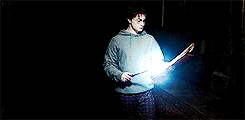
Harry Potter casting the Wand-Lighting Charm
Magic is unable to be performed by Non-magic people (more commonly known as Muggles) which is what separates the Muggle world from the wizarding world. As a substitute for magic, Muggles use technology, but in the same sense, many wizards are ignorant of the workings of most Muggle devices, including electricity. Both the Muggle and the wizard view their choice of tool as completely and utterly logical and ordinary, although each would find the other's tools fascinating or even mysterious.
Squibs are also unable to perform magic, but they are in a unique position, as they are born into wizarding families, which gives them the option to choose between living in the wizarding world like a second-class citizen, or live in the Muggle world while concealing everything they know about magic.
As per the International Statute of Wizarding Secrecy, wizards and witches must constantly hide their magic abilities from the Muggle world, and thus most Muggles are unaware that magic exists.
Transmission and Users
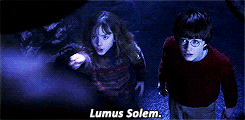
Muggle-born Hermione Granger casting Lumos Solem
In humans, the ability to perform magic, or lack thereof, is an inborn attribute. The former is the norm in the children of magical couples and rare in those of Muggles. The wizarding gene (found in witches and wizards) is dominant, while the non-magical gene (found in Muggles and Squibs) is recessive (see Magic genes for more details).
Those unable to do magic who are born to magical parents are known as Squibs; this is when the non-magical gene resurfaces, causing the offspring to therefore be non-magical. A witch or wizard born to Muggle parents is known as a Muggle-born. This is when a Muggle family is descended from a Squib, and the wizarding gene resurfaces many generations later. Muggle-borns are far more common than Squibs, which may be a feature of the disparate sizes of the Muggle and wizarding populations.
- "Elf magic isn't like wizard's magic, is it?"
- — Ron Weasley contrasts different types of magic[src]
Other intelligent magical beings in the wizarding world, such as veelas, goblins and house-elves, can also perform their own brand of magic, distinctly different from human magic. Other magical creatures may possess their own forms of Rudimentary magic, including fairies.[1]
History of magic
Not to be confused with History of Magic, a Hogwarts class.
Ancient cultures
Like the human race itself, magic is supposed to have originated in Africa.[2] Wizards and witches were known to society at large and were held in high esteem due to their unique powers. Ancient Egyptian wizards placed curses to protect their tombs from plunderers. Ancient Indian wizards created the Snake Summons Spell. The wand was invented in Europe during the B.C. era.[2][3] Dark Magic was practised and evident in ancient Greece, with Herpo the Foul being infamous for pioneering a multitude of forbidden practices, including creating the first known basilisk, as well as the first known Horcrux.[4]
Circa 1000 AD
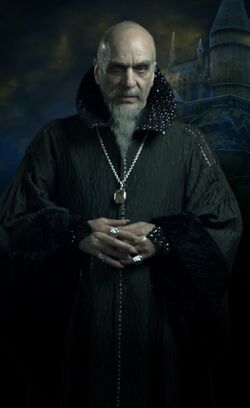
By about the 10th century in Europe, non-magical people slowly became more wary of witches and wizards due to their unique gift. Sensing the growing distrust, four of the greatest British witches and wizards of the age founded Hogwarts School of Witchcraft and Wizardry in Scotland. One of the founders, Salazar Slytherin builds the Chamber of Secrets after his belief that only pure-blood wizards should be allowed into Hogwarts was dismissed. While this idea was considered radical at the time and dismissed, the separation of the two cultures continued and grew over the next 700 years.[5]
1000 to 1300
During this time, the magical population is governed by the Wizard's Council (sometimes referred to as the Warlock's Council). As their relationship with Muggles strains, witches and wizards begin to fraternise with their own kin and grow closer with each other. The Triwizard Tournament and Quidditch become national and international events.[6]
1300s
Paranoia of Wizardkind starts to break into outright hostility, and Witch-hunts spread like wildfire. While they were afraid of magic, Muggles were not very good at recognising it, allowing many a wizard to escape witch burnings unharmed with the use of a Flame-Freezing Charm. Eccentric witch Wendelin the Weird allowed herself to be burned at the stake at forty-seven times in various disguises using a Flame-Freezing Charm, as she enjoyed the sensation.[7][4] Within the wizarding world itself, growing discrimination against other magical beings, such as house-elves and goblins begins to turn up.
15th century

The Tales of Beedle the Bard was written in this time period
With the coming of the Renaissance and the increasing reliance among Muggles on scientific reasoning, the divide between the wizarding and Muggle worlds expands ever wider. Each culture goes on to create their own separate civilization, including social structures, economies, governments, etc. Each borrows a little from the other as the years go by but it becomes apparent that the Muggles must be kept ignorant of the existence of their magical kin for their own good.
Some Muggles persecute their magical neighbours, others try to exploit magical power for their own gain and for quick fixes to their problems. However, Britain continues to have court wizards (Nearly Headless Nick, for example, was a court wizard in 1492). Beedle the Bard writes his Tales to preach a message of tolerance toward Muggles, but his message is subverted or lost over the ensuing centuries as the division between Muggles and Wizards grew.
With the intolerance of Muggles came a growing prejudice among some in Wizarding society in favour of the purity of blood, with Salazar Slytherin's beliefs becoming mainstream. At the end of the 1400s, Daisy Dodderidge built the Leaky Cauldron along a country path outside London as a portal between the Wizarding and Muggle worlds.
17th-19th centuries
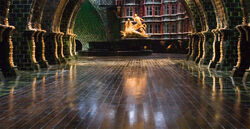
The Atrium of the Ministry of Magic, centre of British magical government
During these years, Goblin Rebellions break out all over Britain, and (perhaps not coincidentally) St Mungo's Hospital for Magical Maladies and Injuries is established. Muggle persecution reaches an all-time high, and it is a very dark time for the magical community.
In 1689, the governments of the wizarding world meet to consider solutions to the crisis and draft the International Statute of Wizarding Secrecy, which calls for all of wizardkind to go into hiding to avoid persecution. The infamous Salem Witch Trials of 1692 only furthers to exacerbate the need for separation, and the law is officially established that same year. With the separation of the two worlds now finalised, all of Wizardkind goes into hiding for good, forming their own isolated communities. In Britain, wizarding families begin to cluster around small towns up and down the country, where they find relative safety and anonymity in numbers. The responsibility of the various wizarding governments in each country is laid out for maintaining the secrecy of everything magical, from Quidditch games to dragons.
The magical governments of each country suppress all exposure of anything magical to Muggles. Over the years, tales of magic becomes the stuff of fairy tales and legend for Non-magical people, with those clinging to a belief in magic being seen as mad.
In the 19th century, facing an increasingly limited amount of space for giants to live in, a war broke out amongst themselves, bringing their species to the brink of extinction. In 1811, Grogan Stump reforms the Ministry of Magic. In 1881, Albus Dumbledore is born.
20th century-present
Prejudice against Muggles and the ideas of pure-blood supremacy is still very strong. These sentiments were manipulated by the notorious Dark Wizard Gellert Grindelwald as he tried to establish a system that enslaves Muggles in fear of the next world war,[8] but he was defeated in 1945 by Albus Dumbledore, in a legendary duel.[9]

Harry Potter's final defeat of Lord Voldemort and the end of the Second Wizarding War
Tom Riddle who would later be known and feared as Lord Voldemort, and the last living descent of Salazar Slytherin, made two attempts to take over control of the wizarding world in Britain. His first attempt, in the 1970s, was cut short on 31 October, 1981, falling to a curse that he cast on Harry Potter which rebounded upon himself.
The Giants, most of whom fought for Voldemort, retreated to northern Europe. Thirteen years later, Voldemort rose again on 24 June, 1994, as he survived thanks to his Horcruxes. He took control of the British Ministry of Magic and Hogwarts (1 August, 1997)[9] but on 2 May, 1998, he was ultimately defeated, once again by having a curse that he cast towards Harry Potter being rebounded upon himself.[10]
Spellcasting
- "There was a lot more to magic, as Harry quickly found out, than waving your wand and saying a few funny words."
- — Learning the difficulty in spellcasting[src]
Minerva McGonagall duelling Severus Snape with a fiery offensive spell through her wand
Spells are the every-purpose tools of a wizard or witch; short bursts of magic used to accomplish single specialised tasks such as opening locks or creating fire. Spells are divided into rough categories, such as "charms", "curses", "hexes", or "jinxes". Typically casting requires an incantation, most often in a modified form of Latin and gesturing with a wand in the case of humans. However, these seem to be aids to the will only; wands merely focuses a person's magic. It is evidently also possible to use a wand without holding it. Harry himself performs Lumos to light his wand when it is lying on the ground somewhere near him. Additionally, Animagi and Metamorphagi do not need wands to undergo their transformations.
A wand focuses magic to such a significant degree, that the vast majority of witches and wizards are often powerless without one. However, one can do magic without a wand, though it is often unfocused and uncontrolled. Still, few wizards can perform directed magic without a wand, if they have enough skill and power, but it is still more difficult and tiring. A wizard or witch is at their best when using their own wand: when using another's, one's spells are not as strong as they normally would be, as dictated by the laws of wandlore.[11]
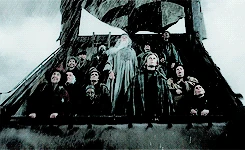
Dumbledore using non-verbal and wandless magic
Spells can be cast non-verbally, but again, most still require a wand for this. This technique is taught in the sixth year of study at Hogwarts and requires the caster to concentrate on the incantation. While most magic requires the caster to use their voice, some do not such as Levicorpus are apparently designed to be used non-verbally. This may depend on the witch or wizard.
Some very skilled and powerful wizards and witches can use magic both wandlessly and wordlessly. Dumbledore has been known to do impressive feats of magic without speaking, such as conjuring enough squashy purple sleeping bags to accommodate the entire student population or his attacks during his duel with Voldemort in the Atrium.
Limits
Regardless of how skilled a witch or wizard is, they are by no means without limits. The following are some of the limits of magical abilities:
Rule of Creation: While it is possible to conjure things out of nothing and duplicate items, it is far more tricky to create something that fits an exact specification rather than a general one. Moreover, a magically imitated object will never be as "real" as the genuine one, with duplicated food being less fulfilling than the real thing,[12] and conjured creatures only demonstrating surface-level behaviour. Furthermore, magically imitated objects tend not to be as resistant to deterioration as the natural ones, being prone to breaking, cracking, melting, rusting, and other forms of breakdown.
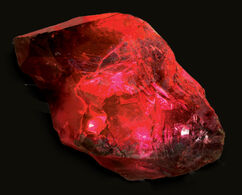
Rule Against Immortality: It is almost impossible to make oneself truly immortal, only to extend one's lifespan using powerful magical means, such as with the Philosopher's Stone[13][14] Creating at least one Horcrux is said to grant the person immortality, as a part of their soul is Earth bound. However it is considered the vilest of acts.[15] Becoming a ghost is other option for wizards and witches; but it is said that this is "a pale imitation of life". Whether or not they are truly sentient beings of independent existence is unclear; as Severus Snape stated that a ghost is merely "the imprint of a departed soul left upon the earth".[16]
- "No spell can reawaken the dead."
- — The limits of magic and its application[src]
Rule Against Resurrection: Likewise, it is impossible to resurrect the dead. While corpses can be transformed into obedient Inferi on a living wizard's command, they are little more than zombies with no soul or will of their own. It is also possible via the rare Priori Incantatem effect to converse with ghost-like "shadows" of magically murdered people. The Resurrection Stone allows one to talk to the dead, but those brought back by the Stone are not corporeal, nor do they wish to be disturbed from their peaceful rest. The result of such a summoning is usually detrimental to the summoner.
Principal Exceptions to Gamp's Law of Elemental Transfiguration
- "Your mother can’t produce food out of thin air, no one can. Food is the first of the five Principal Exceptions to Gamp’s Law of Elemental Transfiguration... It’s impossible to make good food out of nothing! You can Summon it if you know where it is, you can transform it, you can increase the quantity if you’ve already got some.."
- — The exceptions to Gamp's Law of Elemental Transfiguration[src]
The Principal Exceptions to Gamp's Law of Elemental Transfiguration were first mentioned and explained by Hemione in 1997 and again mentioned off-handedly by Ronald Weasley in 1998. Food is one of these: witches or wizards can cook and prepare food using magic, but not create it from nothing. Out of the five exceptions, only food is mentioned explicitly, although speculation has proposed many other possibilities. There is a strong possibility that money is another exception, since if wizards could simply materialise money out of thin air the economic system of the wizarding world would be seriously disrupted. While the Philosopher's Stone does permit alchemy (including, presumably, turning base metals into gold), the Stone is an extremely rare, even unique object whose owner doesn't exploit its powers.
There are numerous examples of food appearing to have been conjured from nothing, such as the sudden materialisation of ingredients in the pots of Molly Weasley's kitchen, Ollivander creating a fountain of wine from the end of Harry's wand,[17] and when Professor McGonagall created a self-refilling plate of sandwiches for Harry and Ron.[18] In all cases, these events can be reasonably explained as food either being multiplied — which is allowable under Gamp's Law, according to Hermione — or transported from elsewhere. One example of this is banqueting in Hogwarts — the food is prepared by elves in the kitchens and laid onto four replica tables, directly below the actual house tables in the Great Hall. The food is then magically transported to the tables.
Other limits
Unsupported flight: While wizards and witches can fly through the air with bewitched objects such as broomsticks, it was long believed that true, unsupported flight was an impossibility. Uncontrolled levitation of a person can be achieved, mostly by charming the clothes they are wearing, but they cannot move freely in midair. Animagi whose forms take on flying creatures may enjoy the sensation of flight, but Anamagi by themselves are quite rare, let alone those whose forms are able to take flight. Thus, true flight was long accepted to be beyond the wizarding world's reach. Eventually, however, Lord Voldemort, one of the most powerful dark wizards of all time, pushed beyond the boundaries of known magic, and discovered a method of flying through the air unaided with full control.[12]
Burning dead flesh: While a living wizard may protect themselves from fire with a basic Flame Freezing Charm, no spell has yet been found to render dead flesh impervious to burning.[19]
Heart removal: In addition, in the story The Warlock's Hairy Heart, the main character removed his heart via dark magic in order to prevent himself from falling in love, while preserving both it and his own life. Such a form of magic is considered impossible outside of the storybook.
Relations with magic
Magic and emotions
- "Of course, it is also possible that her unrequited love and the attendant despair sapped her of her powers; that can happen."
- — The relationship between emotion and magic[src]
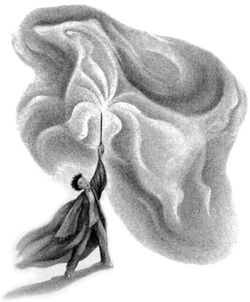
Nymphadora Tonks's wolf Patronus
A witch or wizard's emotional state can affect their inherent abilities. For example, Nymphadora Tonks temporarily lost her power as a Metamorphmagus after suffering severe emotional turmoil and sadness over her grief for the death of Sirius Black, and when Remus Lupin would not return her affections, to the point of going on lethal mission to avoid contact. In effect, the form of her Patronus changed to a wolf (which matched the form of his) to reflect her love for Lupin. In 1995, when Mad-Eye Moody called Tonks by her first name, her hair temporarily turned a violent shade of red out of anger, as Tonks didn't like being identified by her first name.
Wizardkind are weakened when in the presence of Dementors for prolonged periods, as said creatures attack their prey psychologically by making them recall their worst memories. This in turn leaves the victims physically vulnerable. Dementors suck the happiness out of any one in their presence, making it hard to preform magic, as casting spells requires a certain level of emotional stability. This one of the reasons the Patronus Charm is considered such advanced magic. Several magical spells involve the use of emotion when casting them. The Patronus Charm requires the caster to concentrate on a happy memory. Force of will under extenuating circumstances also helps in casting spells, and affects the force with which they are cast. An example of this is when Harry is able to conjure a corporeal Patronus when Sirius Black is in danger of being administered the Dementor's Kiss. Another example of magic and emotions is when Ron Weasley caused it to snow above him with his wand when he felt guilt over breaking up with Lavender Brown without using any worded spells.
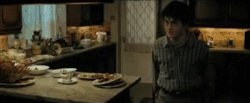
An enraged Harry Potter accidentally inflated his Aunt Marge
As revealed to Harry Potter by Dumbledore during their private lessons, Merope Gaunt only demonstrated any magical ability when removed from her father's oppression, but gave up on magic when Tom Riddle, the man she'd magically compelled to marry her came to his senses and left her. Many other examples of emotion-influenced magic include Ariana Dumbledore (Dumbledore's sister) being emotionally scarred at a young age and then her magic turned volatile and uncontrolled. In addition, Harry magically inflated his Aunt Marge wandlessly and non-verbally, out of sheer anger when she disrespected his parents by calling his father a drunk.
Magic and Love
- "There is a room in the Department of Mysteries that is kept locked at all times. It contains a force that is at once more wonderful and more terrible than death, than human intelligence, than the forces of nature. It is also, perhaps, the most mysterious of the many subjects for study that reside there. It is the power held within that room that you possess in such quantities and which Voldemort has not at all."
- — The power of love and its effect on magic[src]
Arguably the most powerful branch of magic is also the most mysterious and elusive: love. Lord Voldemort, having never experienced love himself, underestimated its influence — to his detriment. It was through love that Lily Evans was able to save her son, Harry, from death by sacrificing her life, so that he might live.
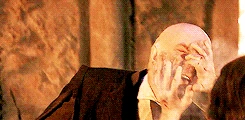
Quirrell's inability to touch Harry in 1991, due to Lily's loving sacrifice
Because of his mother's protection, Harry was unable to be touched by Voldemort. Voldemort attempted to overcome this obstacle by using Harry's blood in his resurrection; however, since Lily's magical protection was in Harry's blood and his blood now flowed through Voldemort's new body, this actually meant that Harry could not be killed by Voldemort while Voldemort himself was still alive. Harry used very much the same mechanism of sacrificial protection to negate the power of Voldemort's spells against the students and teachers of Hogwarts. The exact nature of how "love-magic" works is unknown; it is studied in-depth at the Department of Mysteries where they have a giant cauldron of Amortentia. It is implied that the inability to love is what makes Voldemort as evil as he is. Severus Snape, who voluntarily joined the Death Eaters on leaving Hogwarts, turns spy for the Order of the Phoenix when he realises that the woman he loves is being threatened by Voldemort. Similarly, Narcissa Malfoy’s love for her son Draco eventually leads her to betray Voldemort, directly leading to Harry’s survival — another oversight on Voldemort’s part. With these examples, it is hinted that anybody with the ability to love cannot go as far down the path of evil as Voldemort has done, and it is his complete lack of compassion that makes him capable of what he does.
Magic and death
- Voldemort: "There is nothing worse than death, Dumbledore!"
- Albus Dumbledore: "You are quite wrong. Indeed, your failure to understand there are much worse things than death has always been your weakness."
- — Discussion of the nature of death[src]
The phenomenon of death is studied in detail in a room (called the Death Chamber) of the Department of Mysteries containing an enigmatic veil. Sirius Black falls through this veil after he is hit with a spell from Bellatrix Lestrange, and dies.
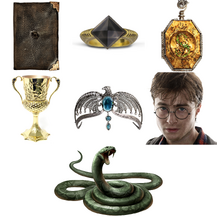
Lord Voldemort's Horcruxes
There are a few magical techniques that have been used to extend life. The Philosopher's Stone can be used to prepare a potion that postpones death for the rest of eternity, so long as the potion is drunk on a regular basis. Voldemort has availed himself of other methods, being one of the few wizards ever to use Horcruxes in his long sought attempt to "conquer death", and is believed to be the only one to use multiple Horcruxes. Legend holds that if one were to possess the three Deathly Hallows, these tools would enable the possessor to become the "master of death." However, being a true "master of death" means being willing to accept that death is inevitable. In addition, the drinking of unicorn blood will keep a person alive even if death is imminent, but at the terrible price of being cursed forever. Being magical can contribute to one's longevity, as there are several people who are quite long-lived (such as Albus Dumbledore, Bathilda Bagshot, and Griselda Marchbanks, who was an invigilator during Albus Dumbledore's O.W.L examinations). This can mainly be attributed to the speed and effectiveness of magical healing, such as potions that cure many sicknesses and ailments including the common cold, spells for instantaneous, scarless healing, and transportation to hospitals being a matter of a few seconds and a side-along apparator or a handful of Floo Powder.
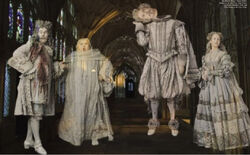
It is revealed by Nearly Headless Nick in 1995 that all witches and wizards have the choice of becoming ghosts when they pass away. The alternative is "passing on". Nick says that he became a ghost because he was foolish, "afraid of death". All Hogwarts headmasters appear in a portrait when they die, allowing consultation by future generations. Dumbledore says that there is no spell that can truly bring the dead back to life, however several cases of dead people becoming half-alive are known. Because of a connection between Harry and Voldemort's wands (Priori Incantatem), images of Voldemort's recent victims appear and help Harry escape. According to Harry, they seemed too solid to be ghosts. While wizards can linger as ghosts or animate dead bodies as Inferius servants, no magic is capable of bringing a dead person back to full and true life. The closest possibility is via the Resurrection Stone.
Study of magic
- "The finest school of witchcraft and wizardry in the world."
- — Rubeus Hagrid praising Hogwarts[src]
It should be noted that, whilst the ability to perform magic usually reveals itself by age seven,[20] there are exceptions when individuals remain mundane until quite late in life when — in extremely desperate circumstances — they suddenly reveal their magical capacity. However, such "late-bloomers" are rare, possibly more so than Squibs.[21] For a person's ability to perform magic to be useful, a good deal of training is required to acquire the correct discipline. When "wild", typically with young and untrained children, magic will manifest itself subconsciously in moments of strong apprehension, fear or anger. A powerful or intelligent wizard or witch can direct this force in less random ways, like Lily Evans and Tom Riddle.
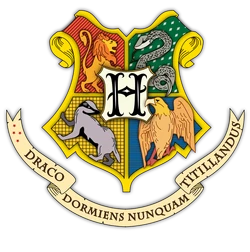
As magic is what governs the wizarding world, there are many people who make it their business to study the magical arts, as well as magic being taught to young witches and wizards. Main fields of magical study taught at the magical school of Hogwarts School of Witchcraft and Wizardry are Arithmancy, Charms, Dark Arts, Divination, Herbology, Potions, and Transfiguration. Types of wizards with special magical abilities include Animagi (wizards who can turn into animals), Arithmancer, a Legilimens (one who can penetrate another's mind), an Occlumens (one who can protect their mind from external penetration), Metamorphmagi (wizards who can change their physical appearance), a Parselmouth (one who can converse with snakes), and a Seer (one who can predict the future). There are also different forms of offensive/defensive magic, as well as the various types of spells: curse, hex, and jinx.
History of Magic
Many witches and wizards study the history of magic throughout time; they are known as magical historians, and History of Magic is also a class taught at Hogwarts. One of the most celebrated magical historians of all time is Bathilda Bagshot, author of A History of Magic, which chronicals the entire history of the magical world up till the end of the First Wizarding War. It remains a standard Hogwarts textbook for this study. The subject has been taught by Professor Cuthbert Binns since the 1700s till present day. The History of Magic is taken in the classroom 4F in Hogwarts.
Arithmancy
Arithmancy is a branch of magic that is concerned with the magical properties of numbers; someone who practises Arithmancy is called an Arithmancer. For example, in the 1200s, Bridget Wenlock, a famous Arithmancer, discovered the magical properties of the number seven. An O.W.L in Arithmancy is required to apply for a Curse-Breaker's job at Gringotts. Arithmancy at Hogwarts is taught by Professor Vector. In her class, students are expected to write essays and to be able to understand complicated number charts, which are part of their homework. Hermione Granger appears to be the only Gryffindor in her year who attempted an O.W.L in this subject (which is her favourite).
Herbology

Herbology
Herbology is the study of magical plants and fungi, including their care and their magical properties and uses. Some magical plants form important ingredients in potions, others have magical effects in their own right. At Hogwarts, all students are required to attempt an O.W.L. in Herbology, so all first through fifth year students take the class, which is taught by Professor Sprout. Herbology classes are held in the greenhouses and include plenty of hands-on activities, including pruning alihotsy bushes, repotting mandrakes, and harvesting bubotuber pus. Students are also assigned essays as homework. Some time in the 2000s the post for herbology was taken by Neville Longbottom since before the start of the 2017 school year Ginny Potter told her son James Sirius Potter to give her love to Neville.
Potions

Love potion, used to create artificial affection
Potions are magical liquids created by mixing various ingredients in a cauldron according to very specific rules. These mixtures must usually be drunk to give their magical effect. The ingredients in potions range from the mundane to the bizarre and fantastic, and the procedures for creating some potions can be complicated and time-consuming. Potions class is taught at Hogwarts School of Witchcraft and Wizardry, and Severus Snape was the Potions Master at Hogwarts from c. 1980 to the fall of 1996. Horace Slughorn took over as Potions Master for the 1996-1997 school year. The Potions classroom at Hogwarts is located in a chilly, dark, and gloomy dungeon. This class is mandatory from years 1-5, but is only allowed at N.E.W.T.-level, if a student has achieved at least an 'Exceeds Expectations' on their O.W.L. exam.
Charms
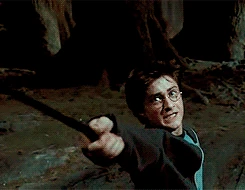
Harry Potter casting the advanced Patronus Charm
Charms are a type of magic spell concerned with enchanting an object to behave in a way that isn't normal for that object. For example, the Summoning Charm brings an object to the caster. Charms is also something of a catch-all for spells that aren't Transfiguration (spells that change the inherent nature of an object). In some sense, if a spell isn't Transfiguration, it's probably a Charm, or else a counter-spell or Healing spell. A Charm might cause something to flash different colours. It might cause an object to levitate or even fly through the air. Charms can make a person laugh or dance or even create a bubble of breathable air around a person's head. In all of these cases, the object or the person doesn't really change, they just do something unexpected. Some Charms can be extremely powerful. The Fidelius Charm, for example, can completely hide a person or a place in such a way that no one can find them unless they are given the location by a Secret-Keeper. Memory Charms can be so strong that they completely remove a person's memory or even damage his or her mind permanently. Charms are in some ways the opposite of curses: Charms seem to have an inherent positive tone (e.g. Tickling Charm) while most curses have an inherent negative one. This is not to say that charms are weaker magic; a well-chosen charm, counter-spell or healing spell is a powerful magical tool against curses, jinxes and hexes. Professor Flitwick, the Hogwarts Charms teacher, was rumoured to have once been a duelling champion, after all.
Transfiguration
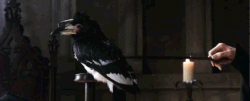
Vera Verto in action
Transfiguration is magic which changes one object into another. It is possible to change inanimate objects into animate ones and vice versa. Some Transfiguration spells alter a part of something, such as changing a person's ears from normal into rabbit ears. At Hogwarts, Transfiguration was taught by Professor McGonagall from 1956 until at least 1997.[22] Albus Dumbledore was the Transfiguration teacher at Hogwarts before her for at least 40 years.[23] Transfiguration spells were cast in ancient times as well. Circe, a witch who lived on the Greek island of Aeaea, was famous for turning lost sailors into pigs. The opposite of Transfiguration is Untransfiguration, which would be returning something to its proper form.
Dark Arts
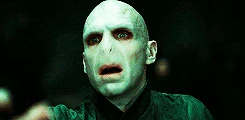
Voldemort casting the Killing Curse, a tool of the Dark Arts
The Dark Arts differ from other forms of magic in the intent of the wizard using it. Most magic is relatively neutral — it can be used for bad or good. Some magic, however, is evil in its intention through and through. Spells of this kind are often called curses. Curses are spells that are often intended to cause harm to another person. This intention to do harm places that spell into the realm of the Dark Arts. However, simply casting a Curse spell doesn't mean that a person is using the Dark Arts. Although offensive and potentially dangerous curses exist in number, three are considered usable only for great evil, which earns them the special classification of 'Unforgivable Curses'. Ultimately, the deep, true intention of the caster is what makes the difference. This is a difficult distinction to make in many cases. However, understanding the difference between acceptable and Dark magic is of key importance for witches and wizards in training, which is why Defence Against the Dark Arts is such an important class for students at Hogwarts. Some other schools have a reputation for teaching the Dark Arts, not Defence Against the Dark Arts; Durmstrang is such a school.
Legilimency

Harry Potter's mind being invaded by Snape during their Occlumency lessons
Legilimency, a branch of magic not normally taught at Hogwarts (at least, not at Ordinary Wizarding Level) is the ability to extract emotions, thoughts, and memories from another person's mind. Although the word literally translates as 'mind-reading,' this is considered a naive interpretation of the art by its practitioners. Someone who practises Legilimency is known as a Legilimens. Legilimency is easier when the spell-caster is physically near the target, and when the target is off-guard, relaxed, or otherwise vulnerable. Eye contact is often essential, so it is useful for a Legilimens to verbally manipulate his or her target into meeting the Legilimens' eyes, with the fringe benefit that the target's emotional state may bring relevant associated memories to the surface. All of this seems to tally quite nicely with what is known of the nature of human memory in Muggle science. The only known defence against Legilimency is Occlumency or the Protective Charm (Protego). The incantation required for it is Legilimens. Some well-known Legilimens are Albus Dumbledore, Lord Voldemort and Severus Snape.
Occlumency
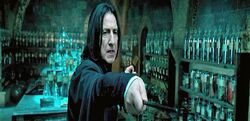
Occlumens Severus Snape preparing to invade Harry's mind, while trying to teach Harry to resist it
Occlumency is the art of magically defending the mind against external penetration, sealing it against magical intrusion and influence — the defensive counter to Legilimency. A practitioner of Occlumency is referred to as an Occlumens. Occlumency is a necessary prerequisite to defeat a Legilimens' lie-detector abilities without suspicious behaviour such as avoiding face-to-face contact and eye contact. Elementary Occlumency involves clearing the mind of thought and emotion, so that the Legilimens can find no emotional ties to memories that the target wishes to conceal. Simple resistance to attack requires similar skills to those needed to resist the Imperius Curse. In its more advanced form, Occlumency allows the user to suppress only feelings and memories that contradict what the user wishes a Legilimens to believe, thus allowing the Occlumens to lie without self-betrayal. Some well-known practitioners of Occlumency were Albus Dumbledore and Severus Snape.
Divination
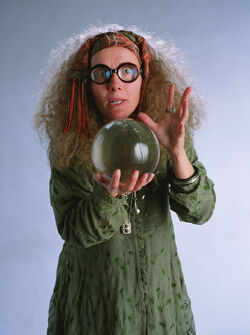
Sybill Trelawney with a crystal ball
Divination is magic which attempts to foresee future events. Many in the wizarding world consider this branch of magic to be imprecise at best. There are several types of Divination. The most imprecise is what is commonly known as "fortunetelling," and this is what Sybill Trelawney teaches at Hogwarts. The second kind of Divination is what is practised by the centaurs. When Firenze the centaur started teaching Divination classes in the spring of 1996, he taught these techniques, although they were mostly lost on the human students in his classes. The third type of Divination is called Seeing. This is true Divination, although what the Seer reveals is usually in the form of a Prophecy which then itself requires some interpretation. A Seer, one who possesses the Inner Eye, doesn't seem to have control over their Seeing. Trelawney, for example, only made actual Prophecies three times, although she made plenty of claims about everything from troubles ahead for various students to Neville breaking a teacup. In each case when she made an actual Prophecy, Trelawney went into a trance and spoke in a completely different voice, and after speaking the Prophecy, she didn't remember a thing about it. True Seeing is very rare, but it has happened plenty of times over the centuries. There is a huge cathedral-sized room of the Department of Mysteries where records of thousands of Prophecies are stored in glass spheres. Each sphere is labelled with the initials of the Seer who spoke the Prophecy and the person it was spoken to and with the subject of the Prophecy.
Magical items & devices
The following devices and items are endowed with various types of magic, that give them certain properties and abilities. They are used by the wizarding community, some items are common, while others are considered rare.
- Wands – Most human magic is done using a wand. The wand serves as a tool to focus and control the magical energy of the spell. It is possible to cast spells without using a wand, but for most wizards results are unfocused. Wands are created from wood with some magical substance at its heart.
- Broomsticks – Brooms are magical mode of transportation in the Wizarding World. They are also used in the wizarding sport Quidditch. There are several different types of broomsticks, such the Nimbus 2000 and the Firebolt. Both of the mentioned broom are international standard. Broomsticks are also the worst kept wizarding secret.
- Deathly Hallows – They are three items: the Elder Wand, Cloak of Invisibility, and Resurrection Stone. They are considered to be a great Wizarding secret and possession of all three is reputed to make the owner the Master of Death. The only known Masters of Death are Albus Dumbledore and Harry Potter.
- Flying Ford Anglia – The Flying Ford Anglia is a turquoise automobile bought by Arthur Weasley. He bewitched it to be able to fly and installed an Invisibility Booster. He also magically expanded the inner spaces so that an enormous amount of luggage could fit in the boot and an amazing number of people could sit comfortably in its wide seats.
- Mirror of Erised – A magnificent mirror, as high as a classroom ceiling, with an ornate gold frame, standing on two clawed feet. The inscription carved around the top read “Erised stra ehru oyt ube cafru oyt on wohsi,” which is “I show not your face but your heart’s desire” written backward.
- Marauder’s Map – This magical map of Hogwarts Castle shows the entire castle and grounds of Hogwarts, including seven secret passages out of Hogwarts and into Hogsmeade. However, it does not show the Room of Requirement or the Chamber of Secrets. The Map uses the Homonculus Charm to keep track of everyone at Hogwarts, and was embedded with a repelling spell directed at Snape.
- Pensieve – A Pensieve is a shallow stone basin with ancient Saxon runes and symbols carved around the edge used to collect and view memories. When in use, a silvery light shines from its contents, which are bright, whitish silver, and cloud-like, moving ceaselessly. Harry thought the stuff in the basin looked like “light made liquid – or like wind made solid”.
- Portraits and Paintings – Portraits are paintings made of certain individuals, namely witches and warlocks. The subject of a magical portrait is sentient due to enchantments placed on the portrait by the painter. The portrait will be able to use some of the subject's favourite phrases and imitate their general demeanour, based on how the subject appears to the painter. However, they are limited in what they can say or do.
The Wizarding World
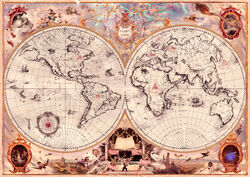
Map of the wizarding schools and their locations around the globe
The wizarding society exists as a shadow society to the Muggle world and works as hard as it can to keep its existence a secret, save for all but a few Muggles. This include those who are related to witches and wizards, or important Muggles such as the Prime Minister .Most things of magical nature are hidden or otherwise obscured from Muggles; others (such as Dementors) simply cannot be seen by them, but Muggles do feel the effects of them. There is also an office in the Ministry of Magic, for the misuse of Muggle artefacts, that deals with people charming objects typically found in a Muggle society.
The International Statute of Wizarding Secrecy was established in 1689 by the International Confederation of Wizards to safeguard wizards from persecution at the hands of Muggles. To most magical people, the Muggle world is unknown and their attempts to disguise themselves as Muggles often have mostly humourous results. Muggle Studies at Hogwarts is considered a soft option.
See also
Behind the scenes
- "I don't believe in witchcraft, though I've lost count of the number of times I've been told I'm a practising witch. Ninety — let's say ninety five percent at least, of the magic in the books is entirely invented by me. And I've used things from folklore and I've used bits of what people used to believe worked magically just to add a certain flavour, but I've always twisted them to suit my own ends. I mean, I've taken liberties with folklore to suit my plot."
- — J. K. Rowling regarding the magic in her books[src]
- It has never been outright specified whether magic itself is a purely biological element, similar to a form of mutation that is passed down among family lines, or if it is an external energy force which magical beings merely tap into for their power.
- According to J.K. Rowling, nobody knows where magic comes from.[24]
- Once it was revealed that Harry Potter was a wizard, use of the word "magic" was forbidden at 4 Privet Drive and the merest mention of it was enough to send Vernon and Petunia Dursley into fits of rage.[25]
Appearances
- Harry Potter and the Philosopher's Stone (First appearance)
- Harry Potter and the Philosopher's Stone (film)
- Harry Potter and the Philosopher's Stone (video game)
- Harry Potter and the Chamber of Secrets
- Harry Potter and the Chamber of Secrets (film)
- Harry Potter and the Chamber of Secrets (video game)
- Harry Potter and the Prisoner of Azkaban
- Harry Potter and the Prisoner of Azkaban (film)
- Harry Potter and the Prisoner of Azkaban (video game)
- Harry Potter and the Goblet of Fire
- Harry Potter and the Goblet of Fire (film)
- Harry Potter and the Goblet of Fire (video game)
- Harry Potter and the Order of the Phoenix
- Harry Potter and the Order of the Phoenix (film)
- Harry Potter and the Order of the Phoenix (video game)
- Harry Potter and the Half-Blood Prince
- Harry Potter and the Half-Blood Prince (film)
- Harry Potter and the Half-Blood Prince (video game)
- Harry Potter and the Deathly Hallows
- Harry Potter and the Deathly Hallows: Part 1
- Harry Potter and the Deathly Hallows: Part 1 (video game)
- Harry Potter and the Deathly Hallows: Part 2
- Harry Potter and the Deathly Hallows: Part 2 (video game)
- Fantastic Beasts and Where to Find Them: The Original Screenplay
- Fantastic Beasts and Where to Find Them (film)
- Fantastic Beasts: The Crimes of Grindelwald - The Original Screenplay
- Fantastic Beasts: The Crimes of Grindelwald
- Fantastic Beasts: The Crimes of Grindelwald (soundtrack)
- Quidditch Through the Ages
- Fantastic Beasts and Where to Find Them
- The Tales of Beedle the Bard
- LEGO Harry Potter
- LEGO Creator: Harry Potter
- Creator: Harry Potter and the Chamber of Secrets
- LEGO Harry Potter: Years 1-4
- LEGO Harry Potter: Years 5-7
- LEGO Dimensions
- Harry Potter: Quidditch World Cup
- Harry Potter: Find Scabbers
- The Queen's Handbag
- Harry Potter: A Pop-Up Book
- The Wizarding World of Harry Potter
- Harry Potter and the Forbidden Journey
- Harry Potter and the Deathly Hallows: Motorbike Escape
- Harry Potter Page to Screen: The Complete Filmmaking Journey
- Pottermore
- Wizarding World
- Wonderbook: Book of Spells
- Wonderbook: Book of Potions
- Harry Potter Limited Edition
- Harry Potter: The Character Vault
- Harry Potter: The Creature Vault
- Harry Potter: The Artifact Vault
- The Case of Beasts: Explore the Film Wizardry of Fantastic Beasts and Where to Find Them
- Fantastic Beasts: Cases from the Wizarding World
- Harry Potter: Hogwarts Mystery
- Harry Potter: Wizards Unite
- The Archive of Magic: The Film Wizardry of Fantastic Beasts: The Crimes of Grindelwald
- Harry Potter: Magical Places from the Films: Hogwarts, Diagon Alley, and Beyond
Notes and references
- ↑ Fantastic Beasts and Where to Find Them
- ↑ 2.0 2.1 Writing by J. K. Rowling: "Uagadou" at Wizarding World
- ↑ Harry Potter and the Philosopher's Stone, Chapter 5 (Diagon Alley) - "The last shop was narrow and shabby. Peeling gold letters over the door read Ollivanders: Makers of Fine Wands since 382 B.C.
- ↑ 4.0 4.1 Harry Potter and the Chamber of Secrets (video game)
- ↑ Harry Potter and the Chamber of Secrets, Chapter 9 (The Writing on the Wall)
- ↑ Harry Potter and the Goblet of Fire, Chapter 12 (The Triwizard Tournament)
- ↑ Harry Potter and the Prisoner of Azkaban, Chapter 1 (Owl Post)
- ↑ Fantastic Beasts: The Crimes of Grindelwald - The Original Screenplay
- ↑ 9.0 9.1 Harry Potter and the Deathly Hallows, Chapter 8 (The Wedding)
- ↑ Harry Potter and the Deathly Hallows, Chapter 36 (The Flaw in the Plan)
- ↑ Pottermore
- ↑ 12.0 12.1 Harry Potter and the Deathly Hallows
- ↑ Harry Potter and the Philosopher's Stone, Chapter 13 (Nicolas Flamel)
- ↑ Harry Potter and the Philosopher's Stone, Chapter 17 (The Man with Two Faces)
- ↑ Harry Potter and the Half-Blood Prince, Chapter 23 (Horcruxes)
- ↑ Harry Potter and the Half-Blood Prince, Chapter 21 (The Unknowable Room)
- ↑ Harry Potter and the Goblet of Fire, Chapter 18 (The Weighing of the Wands)
- ↑ Harry Potter and the Chamber of Secrets, Chapter 5 (The Whomping Willow)
- ↑ Pottermore
- ↑ Harry Potter and the Deathly Hallows, Chapter 11 (The Bribe)
- ↑ http://www.accio-quote.org/articles/1999/0399-barnesandnoble.html#magic
- ↑ Writing by J. K. Rowling: "Professor McGonagall" at Wizarding World
- ↑ Dumbledore taught transfiguration during Newton Scamander's years at Hogwarts which were approximately 1908 - 1915.
- ↑ Barnes and Noble interview, March 19, 1999
- ↑ Harry Potter and the Chamber of Secrets, Chapter 1 (The Worst Birthday)
